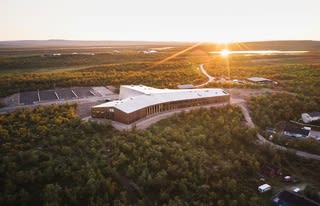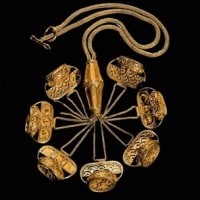ノルウェーの高原に設計された、学校と劇場が一体となった文化・教育拠点〈Čoarvemátta〉
TECTURE MAG 2024.09.02

© Lars Petter Pettersen/Snøhetta
ノルウェー最大かつ最北の高原であるフィンマルク高原の中央部に位置する〈Čoarvemátta〉は、北欧の先住民族であるサーミ人のために建てられた、劇場と学校を併設した新たな文化・教育拠点です。
3方向に分岐する特徴的な建物であり、劇場、工房や教室、学校の管理部門がそれぞれの棟に入っており、エントランスである中央は共用スペースとしてそれぞれの利用者のための集いの場となっています。
建物に入居する各機関を機能的にも建築的にもシームレスにつなぐ、世界各地にスタジオを構える設計事務所 スノヘッタ(Snøhetta)が設計した建築です。
(以下、Snøhettaから提供されたプレスキットのテキストの抄訳)
サーミの遺産と伝統的な建築習慣からインスピレーションを得た新しい文化・教育拠点〈Čoarvemátta〉
スノヘッタは、建築事務所の70°N architectureとアーティストのヨアル・ナンゴ(Joar Nango)とともに計画した〈Čoarvemátta〉は、2021年にサーミ人のための劇場と学校の新校舎を建設するための建築コンペティションにて最優秀案に選出され、先日落成を迎えた。(編集部註:サーミ人は、スカンジナビア半島北部ラップランド及びロシア北部コラ半島に居住する先住民族)
「Čoarvemátta」という名前は、トナカイの角の最も内側で最も強い部分になぞらえ、サーメ語で角と根を意味する言葉に由来する。
サーミ国立劇場Beaivvášとサーミ高等学校とトナカイ放牧学校が入居する〈Čoarvemátta〉において、この名前は各機関の異なる性質と強さ、そして団結力を象徴している。
スノヘッタの設立パートナーであるシェティル・トレーダル・トールセン(Kjetil Trædal Thorsen)は次のように語る。
「私たちは、劇場と学校という、普段は相互運用されることのない異なる機能と建築がシームレスに一体となったプロジェクトに貢献できたことを誇りに思う。また、サーミを象徴する伝統工芸『ドゥオジ』には皮や鼻、角など、動物のものはすべて何かに利用できるという重要な原則があり、これらの重要な役割を果たす資源を〈Čoarvemátta〉にてプロジェクトにうまく利用することができたことを嬉しく思う。」
「〈Čoarvemátta〉が、この建物を共有する機関やサーミ・コミュニティ全体の団結力になることを願っている。」
異なる機能をつなぎ、地域の伝統を受け継ぐ建築デザイン
〈Čoarvemátta〉は、ノルウェー最大かつ最北の高原であるフィンマルク高原の中央に位置するカウトケイノにある。建物のファサードはすべて、建物を取り囲む景観とそれぞれ異なる形で関連している。
建物は景観の中に低く位置し、周囲の丘や高さと調和するプロポーションをもち、有機的なフォルムを壊す鋭角な要素はない。北と南の2面を勾配屋根にすることで、遠くから見たプロジェクトの視覚的な高さを最小限に抑えると同時に、南西からのアクセスに向けたエントランスをつくり出している。
建物の枝分かれした部分は共有スペースであり、その中心にメインエントランスと前庭を配置することで、学校と劇場の両方の利用者が集う場所をつくり出している。ここから建物は3方向に伸びており、劇場、工房と教室、そして学校の管理部門がそれぞれの棟に分かれている。
スノヘッタのシニア・アーキテクトであり、〈Čoarvemátta〉のプロジェクト・リーダーでもある〈ボールド・ヴァーグ・スタングネス(Bård Vaag Stangnes)は次のように語る。
「建物の形状は、劇場と学校に一体的なボリュームをもたせ、集会所という接続点を中心に各機能を集めるというアイデアから生まれた。」
「また、曲線のライン、天窓のある前庭、煙突、目に見える木造の支持構造、入口に向かって開くやわらかな形状の統一された屋根などは、トナカイの放牧が盛んなサーメ地方の伝統的な木造建築ラヴヴ(lávvu)から着想を得たものである。」
それぞれの機能における重要な役割を果たすランドスケープ
建物の枝分かれした形は、自然に3つの屋外スペースを形成しており、特に前庭は、焚き火台や腰掛け石、円形劇場がある親密な空間となっている。
腰掛け石は近くの台地から採取してきたものであり、このフレキシブルな空間は学校と劇場の両方で使用することができる。また、ここで使用されているアルタ・スレートは、建設地近くの採石場で採れたものである。
劇場棟の反対側にある屋外エリアは、学校の建築作業場のためのものであり、風向きやフィンマルク高原の厳しい天候、そして視覚的にも遮蔽されている。
建物の北側に残された広大な敷地に設けられたトナカイ柵は、建物内のトナカイ放牧部門に直結しており、地元の専門家によって建設された。東側は、台地と建物が自然な形で接し、地形と植生ができるだけ建物の近くに保たれている。
パッシブエネルギーを活用した、自然と共生する建築
〈Čoarvemátta〉は、パッシブハウス規格の要件を満たした設計となっているため、この建物は室内気候が良く、必要なエネルギーが極めて少ない。
地中約250mに掘られた40本の地中井戸のおかげで、この建物は冷暖房エネルギーの90%を自給自足している。この井戸から引かれた2台のヒートポンプが建物を冷暖房しており、冬の特に寒い日には電気ボイラーで補う。
建設現場全体では、取り除かれた土は保存されており、一時的に保管された後、建物周辺にすべて戻される。
シニア・ランドスケープ・アーキテクトのテア・クヴァンメ・ハルトマン(Thea Kvamme Hartmann)は次のように語る。
「サーミの文化には、景観を公園や都市空間として育てる伝統はない。ラヴヴから一歩足を踏み出せば、そこは自然の中、つまり風景の中なのである。」
「それゆえに、このプロジェクトにかけた時間の多くは、建設期間終了後、このエリアをどのように緑化し、台地が建物を囲むように戻すことができるかという戦略を立てることに充てられた。」
伝統を反映し、敷地特有の多言語に対応するサインと案内表示
スノヘッタは、このプロジェクトのビジュアルに沿ったサインと案内表示も作成しており、建築、インテリア、ランドスケープデザインを補完的に機能させている。主に機能的なものであるが、建物と同様に伝統的な職人技や素材の使い方もさりげなく取り入れている。
サインは粉体塗装のスチールとパイン材でできており、タイポグラフィやピクトグラムなどのグラフィック要素により建物の配置を反映している。また、多言語(北方語、南方語、ルーレ・サーミ語、ブークモール語)の要件を満たすため、遠くからでも読みやすいようにイコノグラフィが多用されている。
以下、Snøhettaのリリース(英文)です。
New cultural and educational hub Čoarvemátta draws inspiration from Sami heritage and traditional building customs
Snøhetta, together with 70°N architecture and artist Joar Nango, delivered the winning proposal in the architectural competition for a new Sami theatre and school building in 2021. Now, the prominent building has been inaugurated.
The name Čoarvemátta comes from the Sámi words for horn and root, after the innermost and strongest part of the reindeer antlers. This symbolizes different qualities and strengths and represents elements that unite, as Čoarvemátta will be a unifying force for the institutions that share the building: the Sami National Theatre Beaivváš and the Sami High School and Reindeer Herding School.
“We are proud to have contributed to putting this long-awaited and important building in its place. A combined theater and reindeer herding school is a fun program to work with for an architect. It is a testament to good architecture that two really non-interoperable institutions are successfully connected. The project also provides exceptionally good use of resources, which also play a vital role in traditional Sami handicrafts, duodji, where it’s an important principle that everything from the animal can be used for something – the skin, the nostril – and the horn,” says Kjetil Trædal Thorsen, Snøhetta Founding Partner.
“The innermost part of the reindeer horn also symbolizes different qualities and strengths and represents elements that unite, as we hope Čoarvemátta will be a unifying force for the institutions that share the building, and the Sami community at large.”
Design and Architecture
The new building is located in Kautokeino in the middle of Finnmarksvidda, Norway’s largest and northernmost plateau. All four of the building’s facades relate to the various landscape spaces that surround it in different ways.
The building sits low in the landscape and has proportions that harmonize with the surrounding hills and heights with no sharp angles breaking with the organic forms. The sloping roof on two sides (north, south) minimizes the project’s height effect seen from a distance, and at the same time creates an entrance situation towards the access from the southwest.
The new shared space has a branching shape, with a main entrance and vestibule located at its center, creating a gathering place for both the school’s and the theater’s users. From here, the building body stretches in three directions – with one wing each for the theatre, workshops and teaching rooms, and the school’s administration.
The curved lines, the vestibule with skylights as from a reahpen, smoke hole, and the visible load-bearing timber structure in wood, are inspired by wooden structures typical of reindeer herding Sámi areas, such as the lávvu.
“The shape of the building springs from the idea of creating a unified volume for the theatre and the school, and of gathering the functions around a connection point – the meeting place. Elements have also been taken from Sami building traditions – the skylight in the vestibule, the visible supporting structure, and the unifying roof with its soft shape that opens towards the entrance,” says Bård Vaag Stangnes, Senior Architect in Snøhetta and Project Leader of Čoarvemátta.
Materials and color
The façade of the building is made of standing wood clad in ore pine. The massive roof measures 4930 m2 and is clad with 34,000 meters of kebony. The Alta slate stone on the theatre’s gable wall has been reused from the village’s old primary school, which has been demolished.
Inside the vestibule and corridors, the polished concrete floors mimic the ground outside the building, with elements of locally mined stone, including slate and masi quartzite, in various shades of grey and green.
The center of the building, around the foyer, vestibule and theater halls, is painted in warm, red shades. Then the color scheme becomes cooler the further away from the source you get, with bluish tones at each end of the building’s wings. Contrasts between door, wall and floor within the different color schemes have clear references to Sami use of color. This makes a strong contrast to the building’s exterior, which is clad in white for the most part of the year.
Landscape
The branching shape of the building naturally forms three outdoor spaces. The one facing south constitutes the main entrance and a space in front of it. The forecourt is an intimate and circular space with arrán, a fire pit, sitting stones and an amphitheater. The sitting stones are taken from the plateau just outside, and this flexible room can be used by both school and theatre. The Alta slate used here comes from a quarry near the construction site.
The outdoor area on the other side of the theatre wing is intended for the school’s building trade workshops and is shielded both visually and from the prevailing wind direction and harsh weather at Finnmarksvidda.
North of the building, large areas have been set aside for reindeer fences, which are directly linked to the reindeer herding department inside the building and have been built by local experts. On the east side, the plateau meets the building in a natural way, and the terrain and vegetation have been preserved as close as possible to the building.
Natural ground heating
Čoarvemátta meets the requirements of the Passive house standard, which means that the building is of very high quality, with a good indoor climate and extremely low energy requirements.
The building is 90% self-sufficient in energy to heating and cooling thanks to 40 geowells drilled about 250 meters into the ground. The wells supply two heat pumps that both heat and cool the building, while exchangers for the energy wells dump surplus heat back again. On the coldest winter days, the system is supplemented with an electric boiler.
Over the entire construction site, soil that has had to be removed has been preserved, the top layer has been temporarily stored, and subsequently returned to all surfaces around the building, so that the seed stocks are intact.
Restoring the plateau landscape takes time but is allowed as new plants with new roots prevent the original seeds from germinating. On the forecourt, a small amount of grass seeds has been sown that NIBIO has collected in Finnmark, this has been done exceptionally to allow forecourt to turn green faster.
“The Sami culture has no tradition of cultivating landscapes into parks and urban spaces. When you step out of the lavvu, you are directly in nature – in the landscape,” says Thea Kvamme Hartmann, Senior Landscape Architect.
“Much of the project has, therefore, been about creating a strategy for how the area can be revegetated and the plateau return to encircling the building after the construction period has ended.”
Signage and wayfinding
Snøhetta has also also made the signage and wayfinding program that follows the project’s visuality and works complementary to architecture, interior, and landscape design. It is primarily functional, but like the building, it also has subtle references to traditional craftsmanship and use of materials.
The signs are made of powder-coated steel and pine, and the graphic elements, including typography and pictograms, mirror the building’s alignment. Iconography is used extensively for readability at a distance to meet the requirements for multilingualism (Northern, Southern, Lule Sámi, and Bokmål).
Commissioned artworks
KORO, the Norwegian state’s professional body for art in public spaces, has been responsible for the art procurement of Čoarvemátta. A total of six new works of art have been created for the new building. After a closed competition, Máret Ánne Sara (b. 1983) was invited to design the theatre’s stage curtain. Britta Marakatt-Labba (b. 1951) is one of Sápmi’s most renowned contemporary artists, and has created the embroidery Miin Duoddarat / Our Plains, with direct references to the history of the theatre for the building’s common room.
In addition to the new works, two larger, existing works of art by two of Sápmi’s most famous and influential artists, Aage Gaup (1943–2021) and Iver Jåks (1932–2007), have been moved from the old school building to the new building.
FACTS
Shared building for the Sami National Theatre Beaivváš, and the Sami Upper Secondary School and Reindeer Herding School
Location: Kautokeino/Guovdageaidnu, Norway
Size: 7200 m²
Typology: Cultural and educational building
Status: Completed
Timeline: 2020-2024
Čoarvemátta meets the requirements for the designation Passive house according to the standard NS3701
Client: Statsbygg
Architecture, Interior Architecture, Landscape Architecture and Graphic design: Snøhetta
Entrepreneur: Econor
Collaborating partner, architect: 70°N arkitektur
Collaborating partner, architect/artist: Joar Nango
Art acquisition: KORO, curator: Monica Milch Gebhardt
Artists: Máret Ánne Sara, Laila Mari Brandsfjell, Fredrik Prost, Ellen Berit Dalbakk/Rámavuol Elle Bigge, Merethe Ella Márjá Kuhmunen, Elle Valkeapää, Britta Marakatt-Labba, Iver Jåks, Aage Gaup.
Consulting Engineer, Building and Fire: Norconsult
Consulting Engineer, Building (Prefab): AB consult
Consulting Engineer, Acoustics: Brekke & Strand
Consulting Engineer, HVAC: Afry
Consulting Engineer, Pipes: SWECO
Consulting Engineer, Electrical: Rambøll
Consulting Engineer, Road: Asplan Viak
「Čoarvemátta」Snøhetta 公式サイト
https://www.snohetta.com/projects/coarvematta
























